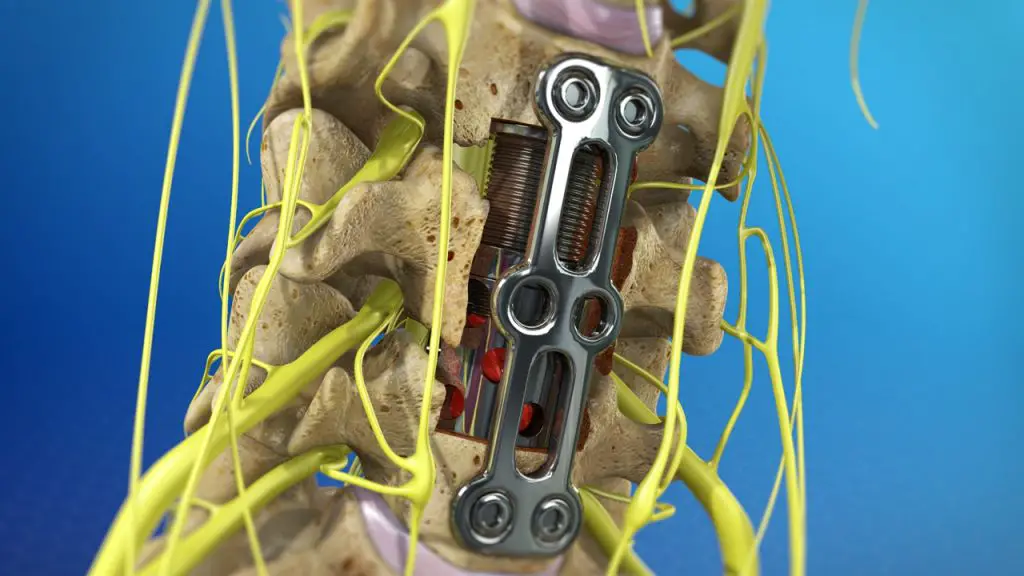Article reviewed and approved by Dr. Ibtissama Boukas, physician specializing in family medicine
Cervical corpectomy is a surgery used when the spinal cord and spinal nerves are compromised, causing pain and disabling symptoms in the affected patient.
This article explains everything you need to know about this type of surgery (difference with other types of surgeries, the procedure, recovery, complications, etc.).
Definition
Cervical corpectomy is a surgical operation to remove one or more vertebrae (bone) of the cervical spine. Its main objective is to decompress nerve roots and/or spinal cord irritated by degeneration or other phenomena.
More specifically, this intervention consists of removing the front part of the vertebra, namely the vertebral bodyAnd the intervertebral disc that can compromise the integrity of the nerves. The rear part of the vertebra, called the posterior arch, is preserved.
Un bone graft is then inserted into the space freed by the removal of the vertebral body. This graft will stimulate bone growth which will eventually connect the above and underlying vertebrae by fusion.
Difference with discectomy
Corpectomy is similar to a related procedure called discectomy. Indeed, these two types of surgeries can be used to treat similar conditions.
The main difference is thata corpectomy is a more invasive procedure, and is generally used when the condition is more complex. For example, the discectomy will only remove the damaged disc, whereas the corpectomy frees the vertebrae in addition to the discs.
Other types of decompressive surgery
Alternatives to corpectomy include:
- Laminectomy
- Laminoplasty
- Discectomy
- Foraminotomy
- Arthrodesis
- Flavectomy
It should be noted that the optimal surgical technique to treat spinal or nerve root compression remains controversial. One approach is not necessarily superior in all circumstances, and the best option will depend on patient-specific anatomical and symptomatic factors.
Indications
Before considering surgery, the doctor may recommend conservative strategies such as medication and physical therapy (physiotherapy). These measures can sometimes be effective in avoiding an operation. However, surgery is usually the recommended treatment lwhen the spinal cord is at risk of damage.
Most often, important and advanced issues spinal cord must be present for corpectomy to be considered. For example, severe neck pain, significant upper extremity weakness, near-constant numbness, lack of coordination, urinary or fecal incontinence, and general loss of function may be observed.
Some medical conditions that can sometimes lead to a corpectomy include:
- narrow lumbar canal
- degenerative disc disease (osteophytes)
- zygapophyseal osteoarthritis
- cervical disc herniation
- fracture and post-trauma
- spine tumor
- cervical deformity
- any other form of spinal cord compression
Procedure
As mentioned, corpectomy involves removing the vertebral body from the vertebrae that put pressure on the spinal cord and spinal nerves.
The intervention is mainly under general anesthesia, anteriorly at the cervical level. An incision is made in the front of the neck, just next to the trachea. The anterior cervical muscles are moved to the side. Particular attention is paid to the surrounding arteries and nerves, so as not to damage them during the surgery.
The operation is done under radiographic guidance, to ensure that the affected vertebrae and discs are removed without irritating the spinal cord and spinal nerves. Once the vertebral bodies are removed, a bone graft is used to fill the remaining space. This graft can be taken from another part of the body (such as a leg bone), or even come from an allograft.
A certain type of internal fixation is usually needed to hold the vertebra and bone graft in place. To do this, a metal plate is generally placed in front of the cervical spine, and it is fixed to the above and underlying vertebrae using metal screws.
Recovery and recovery
Patients usually spend the night in the hospital after the operation, and are discharged the following day. In some cases, the patient can be kept for up to 7 days post-operatively.
In the majority of cases, the surgeon will recommend that the patient wear a cervical collar for several weeks. The role of this neck brace will be to support the cervical muscle, limit extreme movements, and promote healing. It can be removed for eating, washing or sleeping.
In pediatric patients, on the other hand, it is possible that the medical team opts for a halo vest, which is a brace designed to immobilize the neck and head in order to stabilize the injury and aid healing.
On discharge from the hospital, the incision is usually covered with a surgical dressing or sterile bandages. You will be told when to remove them, usually seven days after the operation.
painkillers and/or muscle relaxants will usually be prescribed to control pain and reduce muscle tension. The medication will then be weaned off gradually.
There’s nothing quite like a follow-up visit will usually be fixed 4 to 6 weeks after surgery. X-rays will be taken to observe progress, monitor healing and ensure bone fusion.
Overall, it is estimated that the total recovery period is 6-8 weeks for a corpectomy.
Re-education
Patients are generally encouraged to increase their level of physical activity as tolerated, while refraining from strenuous exercise (eg, activities involving jumping).
To optimize rehabilitation, the doctor may prescribe physiotherapy (physiotherapy). This will speed healing, and promote a safe and effective recovery. The methods used will be:
- Electrotherapy
- Gentle massage
- Soft mobilizations
- Therapeutic exercises
- Advice and education
- Etc.
Note: In some cases, the surgeon will prefer to wait 4 to 6 weeks before starting rehabilitation and exercises for the cervical region.
Complications
From a technical point of view, corpectomy is a fairly complex surgery. Although relatively rare, complications can include:
- neurological deficits due to nerve damage
- spinal cord damage
- damage to the trachea or esophagus
- wound infection
- bleeding
- displacement of the graft
- vertebral artery injury
Source
- https://spine.keckmedicine.org/surgical-treatments/anterior-cervical-corpectomy-and-fusion-accf/
- https://www.neurosurgery.columbia.edu/patient-care/treatments/anterior-cervical-corpectomy#:~:text=A%20corpectomy%20is%20a%20procedure,the%20spine%20in%20the%20neck.
My name is Anas Boukas and I am a physiotherapist. My mission ? Helping people who are suffering before their pain worsens and becomes chronic. I am also of the opinion that an educated patient greatly increases their chances of recovery. This is why I created Healthforall Group, a network of medical sites, in association with several health professionals.
My journey:
Bachelor's and Master's degrees at the University of Montreal , Physiotherapist for CBI Health,
Physiotherapist for The International Physiotherapy Center


